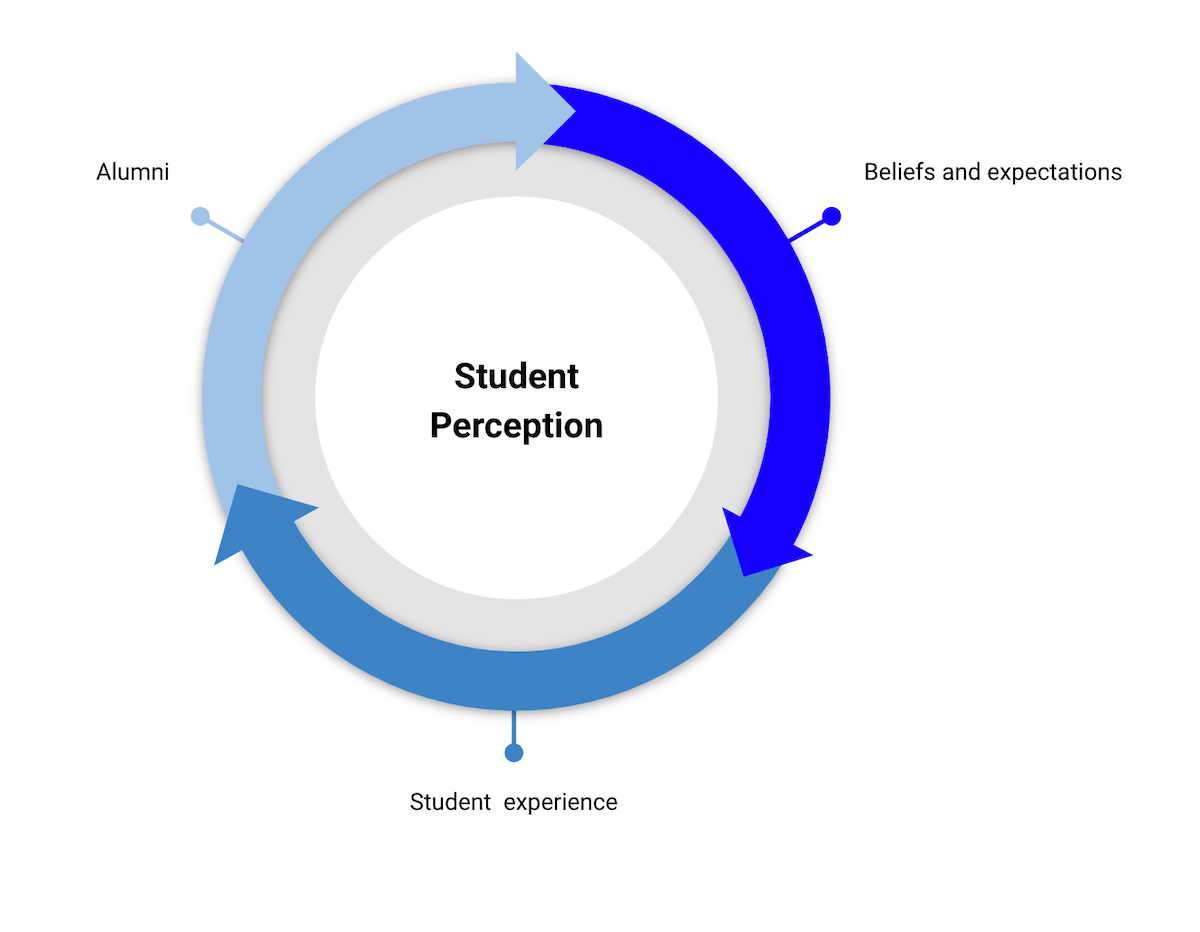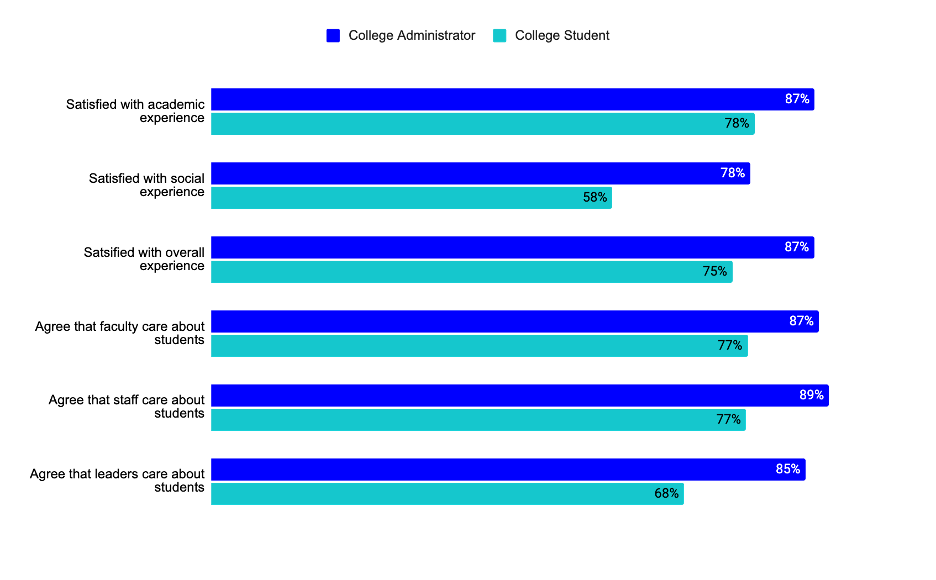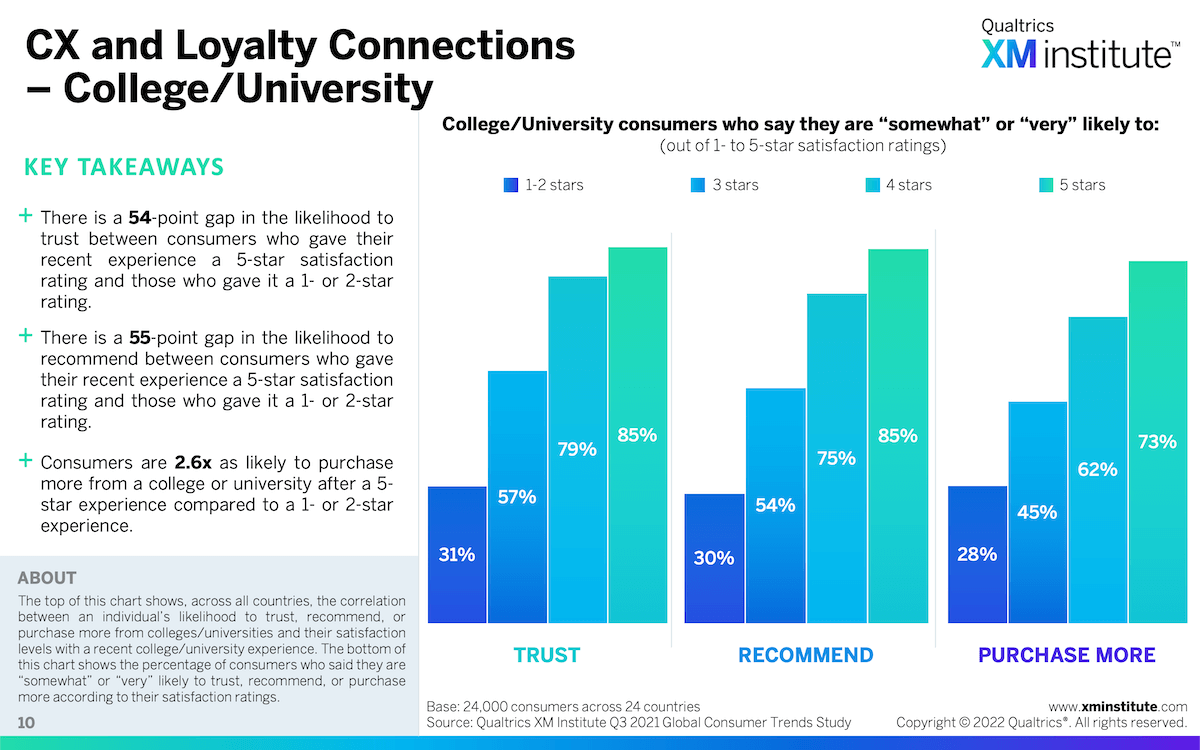What is a student survey?
Designed for students of all ages and types, student surveys enable schools to understand the student experience at any stage of a student’s journey — whether they’re in primary school, middle school, high school, college, or beyond. Through these surveys, schools can capture how students feel — their interests, opinions, level of engagement and satisfaction, and analyse and understand changes in student perception over time.
For those that want to improve the overall student experience, capturing student feedback at every opportunity is vital. In this blog, we’re going to look at how you can use student surveys to measure and improve the overall student experience. First, let’s cover student perception and why it’s important.
Student perception
Student perception is how students understand and interpret their school experiences. It is informed by two aspects of their experience: beliefs and expectations about what the experience should be and the experience itself.

Beliefs and expectations
Before setting foot on campus, students and parents have preconceived expectations about the academic, social, and extracurricular experience. Brand perception, online reviews, conversations with friends and family, and personal beliefs and values, inform these expectations.
Student experience
Every interaction that students and parents have with a school shapes their experience. It begins the first time they communicate, and evolves through every interaction during and after their enrolment. This includes engagement with teachers, administrators, peers; inside and outside of the classroom; as it relates to learning, instruction, extracurriculars, social experiences, facilities, and resources.
Why does student perception matter?
Student perception is important because it allows us to understand student attitudes, emotions, and intentions that we can’t observe through operational and administrative data. By gathering feedback from students, schools can better understand student interest and student satisfaction in the areas that are most important for student outcomes. These include, but are not limited to, student-teacher relationships, classroom environments, student engagement (inside and outside of the classroom), student satisfaction, classroom management, relationships with peers, sense of belonging, and well-being.
You’ve probably heard the adage that “perception is reality” and student perception is no exception. Student perception surveys enable schools to understand the student perception at every stage of the student journey to ensure that they’re having good experiences that align with their expectations.
As an example of why this matters, Qualtrics XM Institute’s research shows that when college students have good experiences, they are more likely to trust their school, recommend it to a friend, and keep coming back for more education.
Student perception as a tool to measure student experience
Perception and experience go hand-in-hand. Measuring student perception is a critical component of a holistic picture of the student experience. But without understanding student perception, schools must rely on operational and administrative data measures such as grades, attendance, and resource utilisation to capture the overall experience.
Schools may also use other stakeholder perspectives, such as educators, school leaders, and parents to augment operational data, but these still don’t provide a comprehensive picture without student perceptions. Additionally, educational research shows variation in student perceptions compared to other stakeholders in K-12 and higher education settings.
Therefore, capturing student perceptions directly from them provides a distinct and important perspective in understanding their experience. In a survey of more than 200 college leaders and more than 1,000 college students, there were large gaps in student and administrator perspectives of the student experience. For example, when asked about the student social experience, 78% of administrators think that students are satisfied with the academic

How to measure student perception
Student feedback is key to understanding student perception. One way to capture this feedback is through a student survey. These surveys provide schools with an authentic understanding of the experience on their campus through direct input and direct feedback.
What should a student perception survey include?
Student surveys are a flexible tool to ask critical questions and collect actionable feedback. With the prevalence of smartphones, tablets, and school-provided or individual computers, schools can administer student surveys online. These surveys should include a combination of close-ended and open-ended questions.
Now, a survey is only as good as the question you ask. With this in mind, the questions you ask in your survey will determine the value of the impact you can have using the information.
If you need help developing your questions, you can use this list of FAQs designed by survey experts.
1. Close-ended questions
Close-ended survey items provide quantitative data that schools can use to set benchmarks, measure change over time, and compare responses between different groups on campus, such as classrooms, grades, or departments. Close-ended questions provide structured response options and can take multiple forms. Two common types are likert and multiple choice.
2. Likert scale
Survey instruments designed to measure student perception often ask questions that use likert scales. Likert scales provide a range of response options that help understand respondent sentiment based on a question or statement.
4. Multiple choice
Student perception surveys may also include multiple-choice questions. Multiple choice survey items can facilitate either single response or multiple response options. They can also include an “Other” option that allows students to write in an option that’s not included in the original options.
5. Open-ended questions
Open-ended survey items are used to collect qualitative data, which allows respondents to provide unstructured text responses. You can use qualitative data to measure sentiment, identify problems or perceptions you didn’t know existed, and help understand the why behind quantitative data. You can then analyse open-ended responses through data visualisations such as word clouds, manual coding for themes, or text analysis tools.
How do I conduct a student perception survey?
1. Plan the survey
Design with the end in mind and ensure your purpose and objectives are clear. Determine who you will survey, when you will survey them (i.e., avoid times when students are unavailable such as holidays or have competing priorities like exams), how you will analyse the responses, and how you plan to share the results and with whom. If you don’t carefully consider these questions at the beginning of your survey design, you may notice something is missing once it’s too late to fix it.
2. Design the survey
Your survey design should follow survey best practices. Some key ones include:
- Avoid lengthy surveys: Keep it as short and simple as you reasonably can to still meet the objectives you set for your project.
- Be direct: Avoid being vague. Make sure your respondents understand what you’re asking.
- Stick to one concept per question: If you try to cover two topics in one question (e.g., Do you like apples and bananas?) you won’t know which item the response is referring to. I hate bananas but I love apples, so my response to that question would not be meaningful.
- Don’t ask leading questions: Avoid biasing your participants to a specific response.
- Ask age-appropriate questions: We always want to ask questions using words that make sense to our audience, and this is especially important with school-aged children because reading comprehension levels will vary significantly across grades.
- Use scales instead of yes/no: When it makes sense, a scale provides a more nuanced understanding of the response than a simple yes/no.
Lastly, always ensure you test your survey! You should take the survey several times to make sure it is set up correctly. Ensure you also test the mobile view and allow stakeholders to review the survey items before the survey goes live.
3. Administer the survey
Survey administration is the process of sending the survey out and collecting responses. An online survey allows students to take the survey at home in their own time, on any device or on campus via a tablet or computer.
Provide students with the opportunity to complete the survey online over two weeks. If you send out an email inviting participants to take the survey, about half of your responses will come in during the three days following the invitation.
Don’t forget to send reminders to anyone who has not already started the survey. However, do bear in mind that you’re likely to see fewer responses with each reminder sent, so set expectations accordingly. If response rates are low, you may need to adjust your strategy with different outreach methods or an incentive for completion.
4. Share the survey findings
Ways to share findings include reports, dashboards, and listening sessions. Reports are static documents that you can share widely as attachments or PDFs, whereas dashboards are dynamic reporting tools that allow users to interact with the data, see changes to data in real time, and filter data by certain variables. Listening sessions are a great way to share findings verbally and hear feedback or answer questions in person or virtually.
5. Act on the survey findings
It is important to show students that you heard their feedback and you are acting on it. Sharing results is the first step, but you also need to demonstrate how you will use them to drive change. Don’t just share the plan once — continue to track progress on your new plan and provide updates on how you are moving the needle. Also, you should readminister student perception surveys, when the time is right, to track whether you are making the desired progress.
Student experience survey template
To get started, you can use this student experience survey template, which focuses on student perception of three key measures of their experience: success, effort, and emotion.
You can customise this template for specific student interactions and should deploy it within a week of contacting a student. For example, you could deploy this survey following an advisory session, a meeting about a loan application, a career services appointment, or a chat on signing up for classes, etc. You may want to remove certain questions based on how applicable they are to your student’s scenario.
Develop an experience management program
If you want to deliver great student experiences, you have to measure the student experience constantly. Best practice is to develop an educational experience management program that measures the student experience by combining operational and experience data throughout the student journey. With this approach, you can continuously identify, analyse and improve outcomes for students — and we can help.
Used by a growing number of educational institutions, the Qualtrics XM Platform, enables you to design, deliver and improve experiences at every stage of the education journey. You can identify root causes to improve outcomes, take action to improve staff and student engagement, and maximise satisfaction and retention. Just check out our solutions below.
See experience management for education in action
